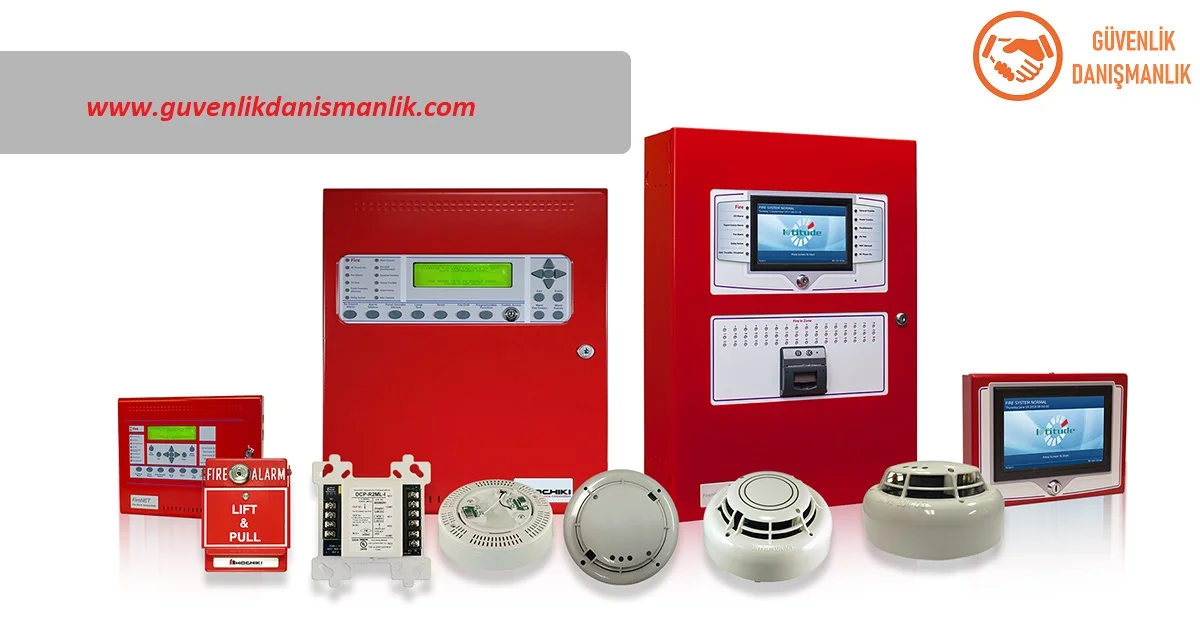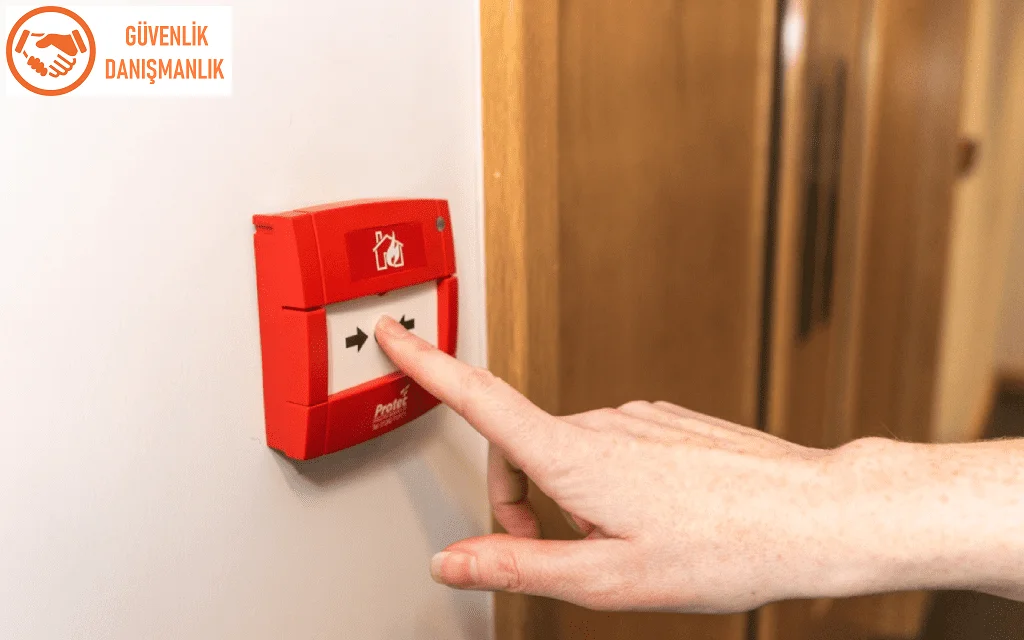In a fire detection system, the components of fire detection systems in both conventional fire alarm and addressable fire alarm systems perform almost the same task and resemble each other. Now, let’s try to identify these components of fire detection systems one by one, because a fire detection system is composed of many elements.
All components such as detectors, buttons, sirens, and various other equipment come together to form the fire detection system. All of these equipment are separate elements that are sold individually and vary depending on the quantity and number of systems to be installed.
Fire detection panels:
Fire panels are considered as the brain of a fire alarm system. All decision-making mechanisms are located on the fire panel. Conventional fire panels are called conventional fire alarm panels, and addressable fire alarm system panels are called addressable panels. Various buttons, LCD or LED display screens are located on the fire alarm panel. Technical settings related to the panel can be made through these buttons and screens. Almost all fire panels operate on 24V, so usually 2 pieces of 12V 7Ah batteries are used to power the fire panel during power outages.
Conventional fire alarm panels can be grouped based on the number of zones. Conventional panels are produced in zone numbers of 2, 4, 6, 8, 12, 16, 32, etc., depending on the space or the number of detectors to be used. Approximately 20 detectors can be connected to each zone. They have a simple structure in principle. Conventional fire alarm systems do not require special programming after installation. These fire panels can be directly put into operation by providing power after installation. There are LEDs on the panel that show the status of the zones. We can receive information about alarms, faults, etc. by looking at these LEDs. In recent years, conventional systems are also produced with LCD screens. Thus, alarm, fault, etc. situations in zones can be monitored from this screen.
Addressable fire alarm panels can be grouped based on the number of loops. Addressable fire alarm panels with loop numbers of 1 loop, 2 loops, 3 loops, 4 loops, 8 loops, etc. are available. On average, 125 to 127 detectors can be connected to each loop line. In some current panels, the number of elements on the loop line can reach up to 256. In addressable systems, panels can be connected to each other as a network. For example, if we installed a 2-loop panel in a building, and new floors were built in the future and the existing panel became insufficient, we could purchase a new 2-loop panel and operate the two panels as if they were a single panel by connecting them to each other as a network. Therefore, addressable panels are expandable fire panels.

Addressable fire alarm panels have a complex and functional structure. Usually, there is an LCD screen in front of the panel. From here, the status of loop circuits and fire detectors and other components can be monitored. Unlike conventional fire panels, they do not operate on a connect-power-on basis. Depending on the fire scenario and the status of the installed fire detection system, they need to be programmed via the panel or with the help of computer software. These panels are usually programmed using computer assistance.
Fire alarm repeater panels:
Repeater panels are a type of panel found in addressable fire detection systems. Its main purpose is to remotely monitor the status of the addressable fire detection panel. These statuses include alarm status, fault status, fault loop status, and the status of loop circuits and detectors, just as we can monitor them from the fire panel, we can also monitor them from the repeater panel. For example, if we want to monitor the status of the fire panel inside the building from the security booth outside the building, we only need to install a repeater panel in the security booth. Pictures of repeater panels are available on the next page.
Optical Smoke Detectors:
Optical Smoke Detectors are detectors that have the ability to detect the smoke generated by flames during a fire. Optical smoke detectors are more sensitive to slow-burning fires with large particulate white smoke. The basic principle of its detection is based on the reflection property of the light inside the optical chamber. When smoke enters this chamber, it scatters the light, which is then absorbed by the detector, resulting in an alarm. Conventional smoke detectors used in conventional systems are called conventional smoke detectors, while those used in addressable systems are called addressable optical smoke detectors. The bases of optical smoke detectors are sold separately and must always be provided with the detector.

The following example images illustrate how an optical smoke detector detects smoke. As can be seen in the picture, the light emitted from the light source is not visible to the light sensor diode under normal circumstances. However, when smoke enters this chamber, the reflected light beam allows the light beam to fall on the sensor diode, and the detection is realized.
Temperature detectors:
Temperature detectors work on the principle of detecting the heat emitted from the flames of a fire. The detector contains a thermistor element that detects temperature, and its resistance value varies with temperature. The principle of detection involves measuring changes in the thermistor element’s temperature value. There are two different types of temperature detectors: fixed-temperature detectors and rate-of-rise temperature detectors.
Fixed-temperature detectors are detectors that give an alarm when a certain temperature value is exceeded. For example, a 58°C temperature detector will give an alarm when the temperature exceeds 58°C.
Rate-of-rise temperature detectors are detectors that detect temperature by measuring the rate of temperature increase. They detect sudden temperature changes, such as a rapid increase in temperature from 25°C to 55°C.
Temperature detectors are not as sensitive as smoke detectors in fire detection. They are particularly used in places where smoke detectors cannot be installed. For example, temperature detectors are used in kitchens, bathrooms, and other places to eliminate false alarms caused by steam.
Combination Detectors (Heat + Smoke Detectors):
Combination detectors are a type of detector that combines both the temperature and smoke detectors described above into one detector. Because they are sensitive to both temperature and smoke, their fire detection level is higher.
Fire Alarm System Buttons:
Fire buttons are essential components of a fire alarm system. They are red buttons that alert people in the building and those who need to intervene in the fire when someone sees a fire and presses the button. In the past, these buttons were of the glass break type, and we could press the button by breaking the glass on the outside with our hands or a hard object. Nowadays, glass break buttons have been replaced by resettable buttons. The buttons used with conventional panels are called conventional fire buttons, and those used with addressable systems are called addressable fire buttons.
Fire Detection System Alarms:
Alarms in fire detection systems are devices with high-power sound that alert relevant people and building occupants during a fire. They have a sound output of up to 110dB. The ones used in conventional systems are called conventional alarms, while the ones used in addressable systems are called addressable alarms. A conventional alarm can be installed in any addressable system if desired, and this is generally a preferred option in applications. Addressable alarms are expensive and draw a lot of current during an alarm, which can reduce the distance of loop lines and the number of devices that can be connected.
Fire Detection System Flashers – Flashing Alarms:
Fire flashers are fire warning elements used in places where it is desired to notify the fire incident with light instead of sound. For example, flashers can be used in hospitals or places where sound would be uncomfortable for people. Similarly, in noisy environments such as factories with high sound levels, the sound of the alarm may not be heard, so flashers can be used instead of sound.

There are also flasher sirens that have both siren and flasher features. These products alert people during a fire with both audible and visual signals.
Fire detection system modules:
Fire detection system modules are used in addressable fire alarm systems. These modules are used to control a wide range of devices and obtain information from them. These modules include input/output modules, relay modules, supervised relay output modules, siren control modules, input modules, zone control modules, and various other modules.
For example, we can use an input module to monitor the location of a fire damper on a particular floor of a building through the addressable fire system.
To connect a CO detector with relay output to the addressable system as an addressable device, we can use an input module.
We can use a supervised relay module to activate a 24V device during a fire and incorporate it into the fire detection system.
Siren control modules are used to operate conventional sirens in different zones through the addressable panel loop.

Input/output modules are used to both monitor and control the contacts of a device.
Through various control modules, such as input/output modules, numerous monitoring and control functions are carried out from addressable fire panels. This enables the creation of fire scenarios during a fire emergency. The ability to use these modules is one of the most important features of addressable fire systems.
Channel Type Smoke Detectors:
Duct smoke detectors are a type of detector used to check for the presence of smoke inside air ducts in buildings. They consist of a normal detector inside a special box. This box is mounted on the outside of the duct. Two sampling tubes extend from the box into the duct to check the smoke status inside the duct. One tube is for air intake, the other for air exhaust.







